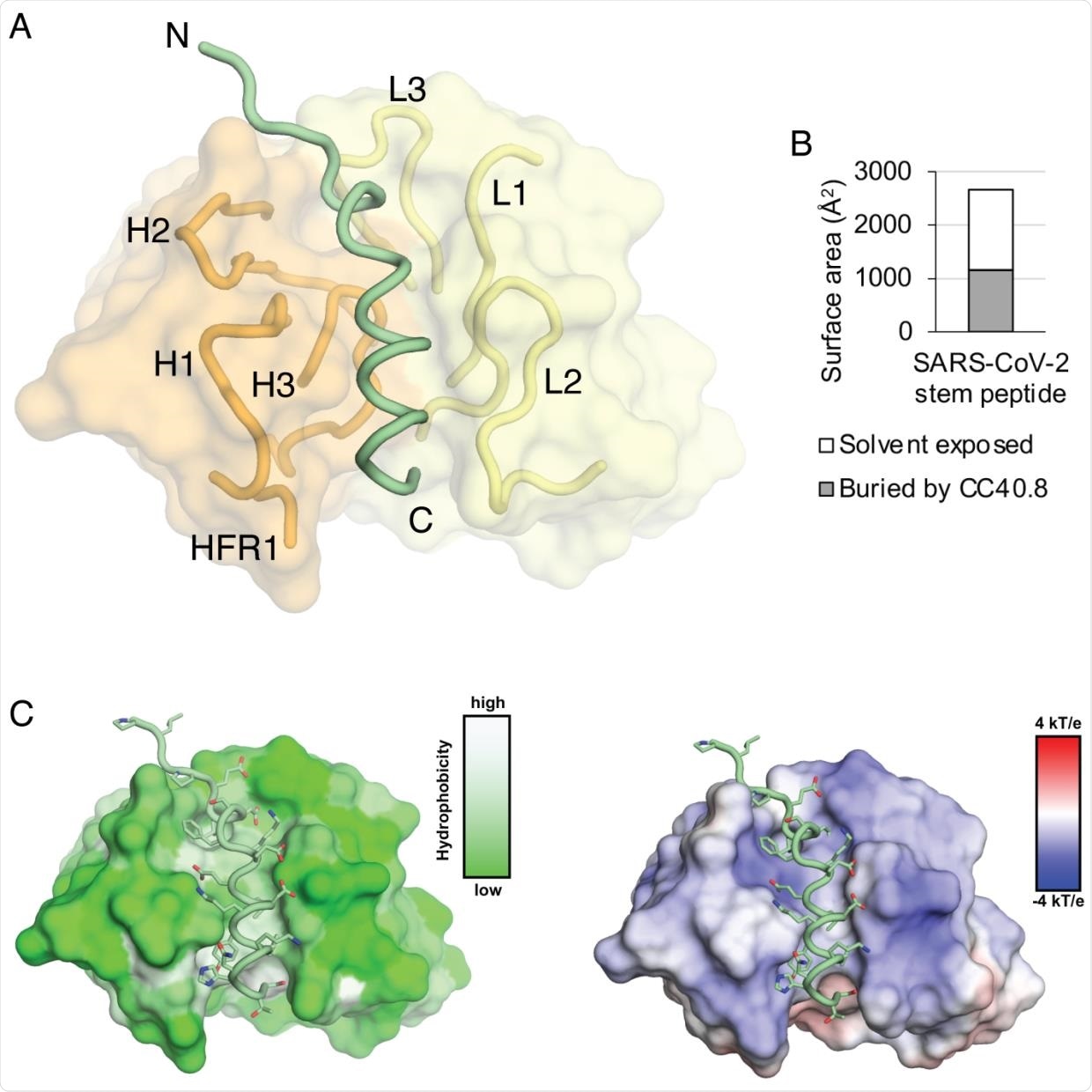Study discovers new target on SARS-CoV-2 spike for protective antibodies

Researchers at The Scripps Research Institute, USA, have described a potential target for coronavirus disease 2019 (COVID-19) vaccines. Dubbed as CC40.8 bnAb, it exhibited broad reactivity with human beta coronaviruses.
The study, which appeared on the pre-print server bioRxiv*, demonstrates that CC40.8 bnAb from a COVID-19 donor targets the conserved S2 stem-helix region of the coronavirus spike fusion machinery.
.jpg)
Study background
Coronaviruses take their name from the crown-like spike proteins that line their surfaces. While coronaviruses only cause common cold-like symptoms, some may cause severe or critical illness.
The severe acute respiratory syndrome coronavirus 2 (SARS-CoV-2), the virus that causes COVID-19, is a novel virus that belongs to the coronaviridae family, of which previously six members have crossed into humans and established widespread infections.
In 2002, severe acute respiratory syndrome (SARS) emerged in China, causing an epidemic. In 2012, another novel coronavirus emerged in Saudi Arabia, called the Middle East respiratory syndrome (MERS).
In December 2019, SARS-CoV-2 was first detected in Wuhan City, Hubei Province, China. To date, it has caused over 129 million cases globally. Of these, 2.81 million people have lost their lives.
These also include four endemic human coronaviruses, such as HCoV-229E, HCoV-HKU1, HCoV-OC43, and HCoV-NL63, which are responsible for non-severe seasonal infections.
All human coronaviruses possess a surface envelope spike glycoprotein that mediates interaction with host cell receptors, allowing virus fusion. The SARS-CoV-2 uses the receptor-binding domain (RBD) of the spike – made up of the S1 and S2 subunits – to bind with the human angiotensin-converting enzyme (ACE2) on host cells for entry and invasion.
The usual target of neutralizing antibodies (nAbs) is the viral spike glycoprotein. On the spike, the RBD is highly immunogenic and can be recognized by most nAbs.
Current efforts in vaccination focus have predominantly targeted the spike glycoprotein. However, due to sequence diversity, there is limited cross-reactivity to the RBD region. Further, the emergence of new variants – resulting in mutations at the RBD – may pose problems in currently used vaccines.
The study
In the study, the researchers found a crystal structure of CC40.8 Fab with a SARS-CoV-2 S2 stem-peptide. The discovered peptide takes in a helical structure. Also, the CC40.8 demonstrates in vivo protective efficacy against SARS-C0V-2 in animal models.
To arrive at the study findings, the team isolated a SARS-CoV-2 cross-neutralizing antibody from a COVID-19 donor. The antibody has shown broad cross-reactivity with human beta coronaviruses.

The CC40.8 is the first human coronavirus S2-stem directed neutralizing antibody isolated from natural infection. It can help in developing antibody-based therapies and vaccines. It can also facilitate the development of a pan-coronavirus vaccine, which can protect against all types of coronaviruses.
“The development of effective pan-coronavirus vaccine strategies that can mitigate future outbreaks from new emerging coronaviruses is important,” the team noted.
The discovery and identification of the new coronavirus spike conserved epitope may help develop bnAb epitope-based vaccine strategies. It can also facilitate antibody-based interventions against human coronaviruses, including future ones with pandemic potential.
*Important Notice
bioRxiv publishes preliminary scientific reports that are not peer-reviewed and, therefore, should not be regarded as conclusive, guide clinical practice/health-related behavior, or treated as established information.
- COVID-19 Dashboard by the Center for Systems Science and Engineering (CSSE) at Johns Hopkins University (JHU) – https://gisanddata.maps.arcgis.com/apps/opsdashboard/index.html#/bda7594740fd40299423467b48e9ecf6
- Zhou, P., Yuan, M., Song, Ge, Beutler, N. et al. (2021). A protective broadly cross-reactive human antibody defines a conserved site of vulnerability on beta-coronavirus spikes. medRxiv. doi: https://doi.org/10.1101/2021.03.30.437769, https://www.biorxiv.org/content/10.1101/2021.03.30.437769v1
Posted in: Medical Science News | Medical Research News | Miscellaneous News | Disease/Infection News | Healthcare News
Tags: ACE2, Angiotensin, Antibodies, Antibody, Cell, Cold, Common Cold, Coronavirus, Coronavirus Disease COVID-19, Efficacy, Enzyme, Glycoprotein, Helix, in vivo, Pandemic, Receptor, Research, Respiratory, SARS, SARS-CoV-2, Severe Acute Respiratory, Severe Acute Respiratory Syndrome, Syndrome, Vaccine, Virus

Written by
Angela Betsaida B. Laguipo
Angela is a nurse by profession and a writer by heart. She graduated with honors (Cum Laude) for her Bachelor of Nursing degree at the University of Baguio, Philippines. She is currently completing her Master's Degree where she specialized in Maternal and Child Nursing and worked as a clinical instructor and educator in the School of Nursing at the University of Baguio.
Source: Read Full Article